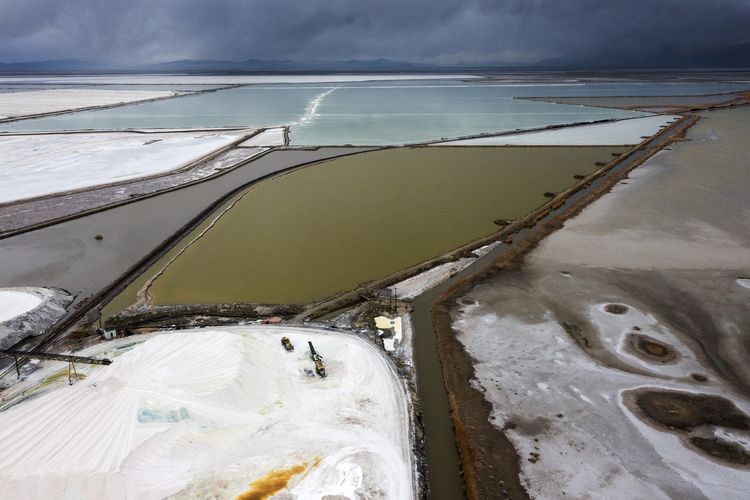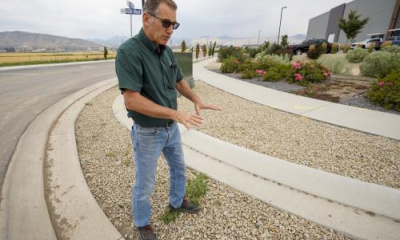Lithium mining also could lead to a greener future and secure more revenue to ensure the lake’s longevity.
Chances are, the Great Salt Lake is part of your daily life, even if you don’t live in Utah.
If you pop open a can of soda in the United States, it more likely than not contains magnesium harvested from the Great Salt Lake, which gives the container its strength. The fruit, vegetables and almonds you buy at the grocery store were likely grown with potash fertilizer produced from material in the lake’s salty water, too. And with the lake’s two largest mineral companies ramping up to harvest one of the world’s hottest commodities — lithium — bits of the Great Salt Lake soon could be found in your phone, laptop and car battery.
And the revenue the state collects from minerals like lithium will also be used to shore up the imperiled lake’s health.
“We know from the science that there [are] fairly large amounts of lithium in the lake,” said Rep. Timothy Hawkes, R-Centerville. “It has been mined in the past, but it wasn’t commercially viable.”
Lithium is the lightest metal in the periodic table, and it’s used in all kinds of things. It makes glass and ceramics stronger. It’s a handy component in car parts and vehicle greases since it holds up well in extreme temperatures. It’s a mood stabilizer that helps treat bipolar depression. It also helpedcreate the hydrogen bomb. It’s in pool chemicals, air scrubbers, polymers and refrigerants.
“It’s used in a multitude of very mundane things that no one ever considers,” said Brian Jaskula, a mineral commodity specialist who has researched lithium for the U.S. Geological Survey since 2008.
For decades, the United States was the largest producer of lithium, with the bulk of it coming out of a hard rock mine in North Carolina. Then, a small fertilizer company called SQM in Chile’s Salar de Atacama salt flat borrowed a form of lithium extraction first pioneered in Nevada.
The method “mines” materials from salt brine. That mineral-rich water is held in shallow ponds, which evaporate and concentrate its resources.
“In order for them to be economic and achieve the lowest production costs, they have to be blessed with a nice, hot, dry environment,” Jaskula said of brine mineral harvesting. “And the Salar de Atacama is the driest place on Earth.”
Evaporative extraction of lithium proved more cost-effective than hacking it out of a mountain since the sun does most of the work. By the 1990s, SQM was able to sell its lithium at half the price of traditional mines.
“As a result, hard rock wasn’t able to compete” in the U.S., Jaskula said, “so they all went out of business.”
Why lithium works well in computers, smartphones and electric vehicles
Around the same time, consumer electronics became more widespread. Manufacturers soon realized lithium was an especially useful ingredient for making batteries.
“It has this outer electron it really wants to get rid of,” Jaskula said. “Because of that reactivity … it has the benefit of having a lot of innate energy in it, as well as being very light.”
Lithium-ion batteries are now prolific in computers and smartphones. But in recent years, one product, in particular, is driving a surge in demand for the mineral: electric vehicles.
In 2015, batteries eclipsed glass and ceramics as the dominant end-use of lithium, and that use continues to mushroom. Last year, 74% of the world’s mined lithium went to batteries. By 2030, CNBC reports, more than 90% of lithium demand will likely be fueled by electric vehicles.
Sometimes referred to as “white gold” by investors, the price of lithium ballooned from just over $6,000 per metric ton in 2012 to $17,000 last year, according to USGS estimates. But the true cost of lithium is known only by peddlers and buyers of the product, Jaskula said, and it may be selling for much more.
“The last half of this decade, the demand is going to be in excess of what production can come up with,” he said. “There’s this mad scramble for all these existing operations to expand their capacity, and for new mines to come online.”
China consumes the most mined lithium in the world. It has contractsfor up to 95% of the lithium mined in Australia, making that nation the largest producer of the material, followed by Chile.
“Even the most unimpressive lithium operation, if there’s even a chance it will become economical, China will make a deal,” Jaskula said. “They’re the No. 1 battery maker now, and their mega-factories are going to be increasing at a logarithmic growth rate.”
U.S. lags in lithium production
Electric vehicles are steering China’s insatiable appetite for lithium, Jaskula said. They’re also a key component in President Joe Biden’s efforts to modernize infrastructure and combat climate change in the United States. The U.S. Department of Transportation and the Department of Energy announced in February a $5 billion investment to build out a charging network across the nation’s highways.
But the U.S. lags in domestic production of some of the crucial materials, including lithium, needed to build a greener future.
A number of companies and organizations throughout the nation are experimenting with innovative ways to economically extract lithium, including a geothermal project at California’s Salton Sea. Still, the USGS reports only one viable domestic operation: a brine extraction mine at Nevada’s Silver Peak that’s been in business since the 1960s.
Because it’s currently the nation’s only lithium mine, USGS doesn’t share data about Silver Peak to protect proprietary information. But The New York Times reported last year the outfit extracts about 5,000 tons annually. That’s a mere drop in the bucket of worldwide lithium production, which USGS pegged at 100,000 tons last year.
The Biden administration, meanwhile, announced last month that it’s pouring $30 million into research to help U.S. companies source local sources of lithium, cobalt, nickel and other critical elements for green technologies. The supply issues the nation faced in the wake of the coronavirus pandemic were apparently a wake-up call.
“Because of the way the market is going now,” Jaskula said, “the U.S. and other countries are finally bringing back mineral refining capacity.”
Enter the Great Salt Lake.
How the Great Salt Lake is getting in the lithium game
Utahns have extracted minerals from the Great Salt Lake since at least 1847, when a group of pioneers gathered 125 bushels of crude salt from its shores. Today, it contributes more than $1 billion to the state’s economy.
One of the lake’s largest mineral harvesters, Compass Minerals in Ogden, got its start in the late 1960s as Lithium Corp of America. The company quickly realized fertilizer was a more profitable venture, at least at the time. It’s now the largest producer of sulfate of potash in the Western Hemisphere, a nutrient used to grow a variety of produce, including grapes, potatoes and nuts.
But Compass is going back to its roots and investing in lithium once again.
In October, the company announced it had successfully converted lithium brine into battery-grade lithium carbonate. Compass expects to send its lithium product to the market by 2025, according to a news release, and it currently has two lithium chiefs on its nine-member executive team.
Compass CEO Kevin S. Crutchfield said the company’s Great Salt Lake operation has a “2.4 million ton lithium brine resource.” It plans to generate up to 25,000 metric tons of battery-grade lithium each year, with as much as 65% of production sourced from brine Compass already has evaporating in its 55,000 acres of ponds.
Across the lake, in Tooele County, US Magnesium has produced its namesake mineral from Great Salt Lake brine for half a century. It’s virtually the only magnesium mine in North America (China accounts for about 75% of the global magnesium supply, according to USGS) and 50% to 75% of the cans and certain car parts manufactured in the U.S. likely have magnesium that originated in the Great Salt Lake.
In recent years, the company has had an eye on a second product.
“About 10 years ago, we started recognizing the value of the lithium,” said Tom Tripp, a Tooele County Council member and director of technical services for US Magnesium.
Rather than pulling more water out of the desiccated Great Salt Lake, the company is using its own mining waste, where lithium is concentrated as a byproduct.
“This was a residue that had no commercial value to us at the time,” Tripp said, “so it got stacked in the backyard and accumulated for 50 years.”
In 2018, US Magnesium quietly broke ground on a lithium production facility. The plant now has the capacity to produce 10,000 tons a year, according to a brief post on the company’s website.
Tripp sees future potential for the mineral beyond car batteries.
“Someday, if you’re going to get into solar power in a real [utility-scale] way … you’ve got to be able to store a lot of power to get you through the dark,” he said. “You’ve got to have massive battery banks.”
How will mining impact the struggling Great Salt Lake?
The Great Salt Lake hit a record low last summer, and with Utah’s prolonged and persistent drought, there’s little relief in sight.
State lawmakers toured the lake via a helicopter in February, taking in its vast, parched lakebed. They passed a slew of water conservation bills in response. Among them was HB157, sponsored by Hawkes, which creates a special account for the Great Salt Lake, ensuring the royalties collected from mineral extraction are reinvested to improve the lake’s health.
“Where the lake has such significant needs,” Hawkes said, “let’s protect the resource generating the revenue.”
It’s unclear how much of a windfall lithium mining will generate for Great Salt Lake restoration since extraction of the mineral is still in its early stages. But royalties from current brine-harvesting operations generate between $5 million and $13 million each year, according to Laura Vernon, Great Salt Lake coordinator for the Utah Department of Natural Resources.
“They’re still working hard at generating lithium and becoming profitable,” Vernon said. “It would be a great bonus, a tremendous asset, but I couldn’t say how much.”
Before Hawkes’ bill created a Great Salt Lake account, royalties from its minerals went to things like keeping the state Fairpark afloat, reopening national parks when the federal government shut down and rehabilitating sage grouse habitat. Hawkes said the mineral companies lobbied lawmakers to keep that revenue local before the lake’s ecosystems — and its industries — collapse.
“They’ve long felt, ‘Geez, we pay all these royalties to the state, and now the source is at risk,” Hawkes said.
The push for more domestic sources of minerals comes with risks to natural resources like the Great Salt Lake. Proposed lithium mines across the country face protests and legal battles from nearby communities and native tribes, who fear increased pollution and depletion of precious water resources.
While solar evaporation mining is touted as more environmentally sound than typical hard rock or open pit mines, it isn’t without impacts.
US Magnesium, formerly called Magnesium Corp., was once dinged as the largest polluter in the nation. Its emissions discolored cars and gave workers headaches, brittle hair and respiratory problems, according to a High Country News report from 1996.
Just last year, the U.S. Environmental Protection Agency reached a settlement with the plant over illegal hazardous waste disposal. The agency required US Magnesium to build a barrier wall that prevents leaks to the Great Salt Lake, along with a filtration plant, at a cost of at least $37 million.
“It’s laudable to say we should be doing our own extraction for the things that we’re going to use,” said Aimee Boulanger, executive director of the Initiative for Responsible Mining Assurance, or IRMA. “However ... it’s not like we’re going to be doing the extraction of lithium from affluent communities who are driving their brand-new electric vehicles.”
Since 2006, IRMA has worked with mining industries to develop a standard for responsible mineral development that assesses environmental impacts, fair labor and social responsibility for mines. Mining and end-use companies volunteer to adopt all or part of the standard. IRMA finalized its list of more than 400 best practices in 2018 and began auditing mines in 2019. Lithium brine operations in South America were among the first mines to sign up for an assessment.
“They know the expectation is they’re supposed to be selling themselves as part of a climate-stressed world solution,” Boulanger said. “You didn’t have to convince them.”
While Boulanger said she hasn’t heard from any Great Salt Lake operations so far, the industry causing lithium demand to soar — car manufacturing — is getting on board with sourcing their materials from mines meeting IRMA requirements. BMW was the first carmaker to join IRMA in 2020. Mercedes-Benz, Ford, GM and Volkswagen have since followed, and Boulanger said another U.S.-based manufacturer is set to announce its partnership next week.
“There’s a shared sense, as we move to a needed transition on energy fuels, that we all still need to be looking at the impacts,” Boulanger said. “... We need to make sure that our solutions don’t cause more problems than they were set to solve.”









